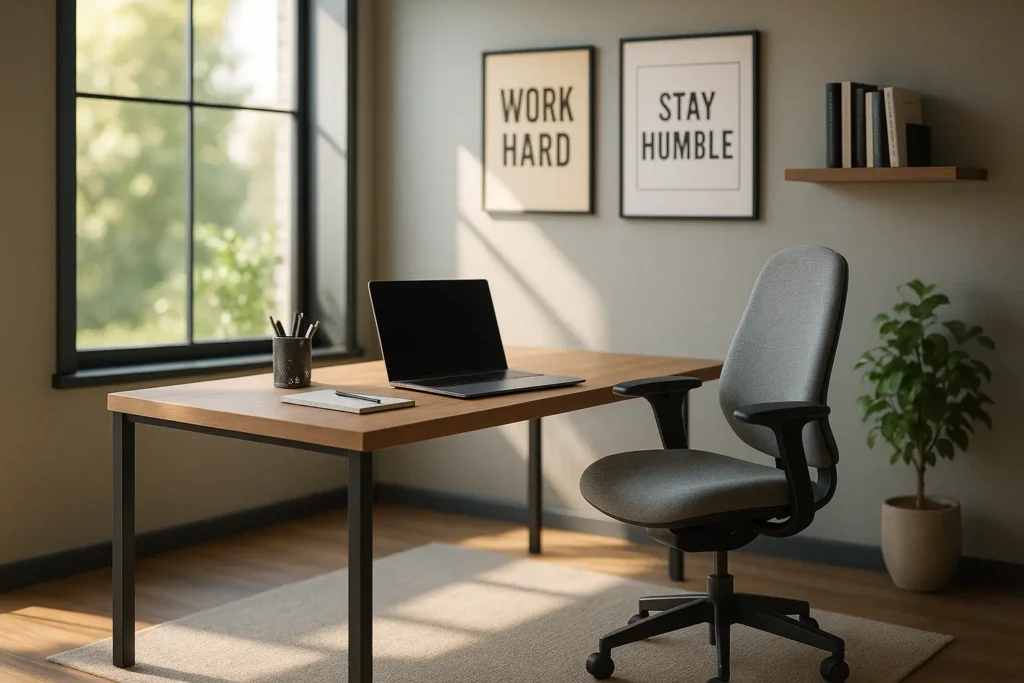In our fast-paced world, time is one of our most valuable resources. We’re constantly seeking ways to do more in less time, often overlooking the environment in which we work. But what if the key to unlocking greater productivity lies not in the latest app or gadget, but in the very space we occupy? Recent neuroscience research reveals how our surroundings can influence our mental focus and drive. Let’s explore how the design and setup of a room can make us more productive.
The Science Behind Space and Productivity
Neuroscience has long delved into how our brains respond to different stimuli, and the environment is a key player. Spatial design affects how we work and think in profound ways. By understanding this, we can curate spaces that enhance our attention and efficiency.
The Role of Sensory Input
From the moment we step into a room, our brains are bombarded with sensory data. The lighting, colors, textures, and sounds all send signals that can either boost our focus or sap our energy. Studies show that natural light, for instance, helps regulate our circadian rhythms, leading to better sleep and increased daylight awareness. In contrast, stark artificial lights can increase fatigue, making us less inclined to stay on task.
The Impact of Clutter
Clutter is not just an eyesore; it’s a productivity killer. A cluttered desk can lead to a cluttered mind. Neuroscientists believe that clutter competes for our attention, making it difficult to concentrate on the task at hand. By maintaining a tidy workspace, we eliminate distractions, allowing our minds to hone in on more pressing matters.
Sound and Silence
Not everyone thrives in silence. While some need quiet to concentrate, others find a moderate level of background noise, such as ambient music, can enhance their focus. Noise-canceling technologies have become popular tools for those who need to create a silent sanctuary amid bustling environments.
Designing for Focus: Practical Applications
Now that we understand the principles of how our environment affects our brain and work habits, let’s dive into practical ways we can design spaces that promote productivity and well-being.
Choosing the Right Colors
Colors can evoke emotions and set the tone for our work. Blue, known for its calming effects, enhances focus and creativity. Yellow, associated with happiness, can inject positivity into our day. By carefully selecting the colors in our surroundings, we can tailor the ambiance to support our tasks.
Ergonomics and Comfort
Comfort is critical when it comes to long hours spent at a desk. Investing in ergonomic furniture can prevent injury and improve well-being. Consider a chair that supports the spine, a desk at the right height, and an adjustable monitor to reduce eye strain. A comfortable setup encourages us to spend more time engaged with our work.
Adding Natural Elements
Biophilic design, which incorporates natural elements, can significantly enhance our mental state. Plants, for example, improve air quality and introduce a soothing green aesthetic. The presence of natural materials like wood and stone can also create a calm atmosphere, promoting a sense of tranquility.
Personalizing Your Space
Our workspace should reflect who we are. By adding personal touches, such as photos, art, or meaningful objects, we create a space that feels uniquely ours. This personalization can boost our motivation and make us more inclined to stay engaged with our tasks.
Balancing Technology and Human Needs
In an era where technology is ever-present, it’s crucial to strike a balance between digital tools and human needs. While technology offers ways to streamline our tasks, it can also lead to distractions if not properly managed.
Digital Minimalism
With so many apps vying for our attention, it’s easy to become overwhelmed. Practicing digital minimalism involves curating the apps and tools we use, ensuring they add value to our daily lives. This approach helps us maintain focus and avoid the trap of constant notifications and alerts.
The Power of Breaks
Our brains aren’t wired to focus for extended periods without rest. Implementing the Pomodoro Technique or scheduling regular breaks can prevent burnout and boost overall productivity. Stepping away from screens and engaging in a brief physical activity can refresh our minds, preparing us for more intensive work.
Mindful Integration
Integrating technology in a way that complements our natural rhythms is essential. Tools like adjustable lighting systems that mimic natural daylight cycles or apps that prompt relaxation exercises can align our work environments with our biological needs, promoting a healthier work-life balance.
As we navigate the demands of modern work, the importance of our physical surroundings cannot be understated. By harnessing the insights from neuroscience and designing spaces that cater to both our cognitive and emotional needs, we unlock the potential for enhanced productivity and satisfaction. Whether it’s maximizing natural light, decluttering, or incorporating personalized elements, a thoughtful workspace can transform our daily routines.
As we continue to explore the interplay between environment and efficiency, let’s remember that a room isn’t just a place to work—it’s a canvas upon which we paint our personal journeys of growth and achievement.
FAQ
What role does lighting play in enhancing productivity in a room?
Natural light significantly impacts alertness and mood, leading to increased productivity. It helps regulate the body’s natural sleep-wake cycle, ensuring better focus and energy levels during the day.
How can color schemes influence work efficiency in a workspace?
Colors can evoke certain emotions and reactions. For instance, blue promotes a sense of calm and focus, while yellow can stimulate creativity. Choosing the right color palette can enhance motivation and concentration.
What type of furniture arrangement is most conducive to productivity?
Ergonomically designed furniture that supports good posture is essential. Desks and chairs should be adjustable to fit individual needs, and an organized layout can minimize distractions and streamline workflow.
Can indoor plants have an impact on cognitive function?
Yes, having indoor plants can improve air quality, reduce stress, and increase concentration. They create a calming environment that boosts mental clarity and creativity.
How does noise level affect productivity in a workspace?
Excessive noise can be distracting and decrease focus. Using soundproofing materials or white noise machines can create a quieter environment that enhances concentration and efficiency.


